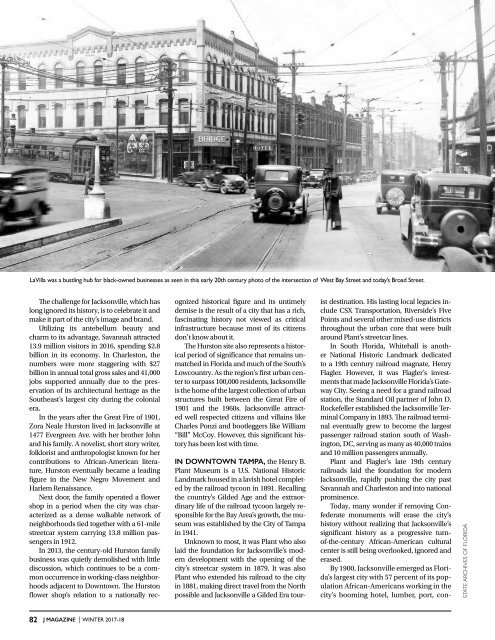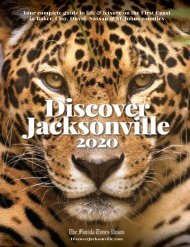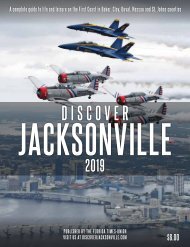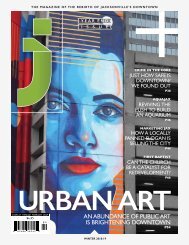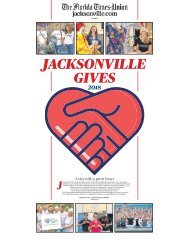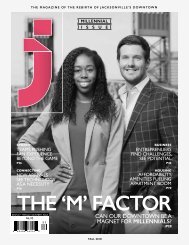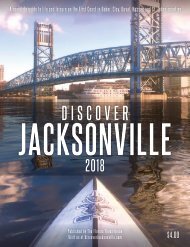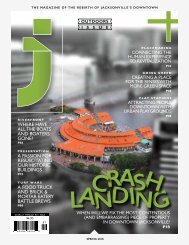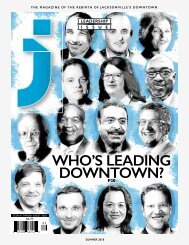J Magazine Winter 2017
The magazine of the rebirth of Jacksonville's downtown
The magazine of the rebirth of Jacksonville's downtown
Create successful ePaper yourself
Turn your PDF publications into a flip-book with our unique Google optimized e-Paper software.
LaVilla was a bustling hub for black-owned businesses as seen in this early 20th century photo of the intersection of West Bay Street and today’s Broad Street.<br />
The challenge for Jacksonville, which has<br />
long ignored its history, is to celebrate it and<br />
make it part of the city’s image and brand.<br />
Utilizing its antebellum beauty and<br />
charm to its advantage, Savannah attracted<br />
13.9 million visitors in 2016, spending $2.8<br />
billion in its economy. In Charleston, the<br />
numbers were more staggering with $27<br />
billion in annual total gross sales and 41,000<br />
jobs supported annually due to the preservation<br />
of its architectural heritage as the<br />
Southeast’s largest city during the colonial<br />
era.<br />
In the years after the Great Fire of 1901,<br />
Zora Neale Hurston lived in Jacksonville at<br />
1477 Evergreen Ave. with her brother John<br />
and his family. A novelist, short story writer,<br />
folklorist and anthropologist known for her<br />
contributions to African-American literature,<br />
Hurston eventually became a leading<br />
figure in the New Negro Movement and<br />
Harlem Renaissance.<br />
Next door, the family operated a flower<br />
shop in a period when the city was characterized<br />
as a dense walkable network of<br />
neighborhoods tied together with a 61-mile<br />
streetcar system carrying 13.8 million passengers<br />
in 1912.<br />
In 2013, the century-old Hurston family<br />
business was quietly demolished with little<br />
discussion, which continues to be a common<br />
occurrence in working-class neighborhoods<br />
adjacent to Downtown. The Hurston<br />
flower shop’s relation to a nationally recognized<br />
historical figure and its untimely<br />
demise is the result of a city that has a rich,<br />
fascinating history not viewed as critical<br />
infrastructure because most of its citizens<br />
don’t know about it.<br />
The Hurston site also represents a historical<br />
period of significance that remains unmatched<br />
in Florida and much of the South’s<br />
Lowcountry. As the region’s first urban center<br />
to surpass 100,000 residents, Jacksonville<br />
is the home of the largest collection of urban<br />
structures built between the Great Fire of<br />
1901 and the 1960s. Jacksonville attracted<br />
well respected citizens and villains like<br />
Charles Ponzi and bootleggers like William<br />
“Bill” McCoy. However, this significant history<br />
has been lost with time.<br />
In Downtown Tampa, the Henry B.<br />
Plant Museum is a U.S. National Historic<br />
Landmark housed in a lavish hotel completed<br />
by the railroad tycoon in 1891. Recalling<br />
the country’s Gilded Age and the extraordinary<br />
life of the railroad tycoon largely responsible<br />
for the Bay Area’s growth, the museum<br />
was established by the City of Tampa<br />
in 1941.<br />
Unknown to most, it was Plant who also<br />
laid the foundation for Jacksonville’s modern<br />
development with the opening of the<br />
city’s streetcar system in 1879. It was also<br />
Plant who extended his railroad to the city<br />
in 1881, making direct travel from the North<br />
possible and Jacksonville a Gilded Era tourist<br />
destination. His lasting local legacies include<br />
CSX Transportation, Riverside’s Five<br />
Points and several other mixed-use districts<br />
throughout the urban core that were built<br />
around Plant’s streetcar lines.<br />
In South Florida, Whitehall is another<br />
National Historic Landmark dedicated<br />
to a 19th century railroad magnate, Henry<br />
Flagler. However, it was Flagler’s investments<br />
that made Jacksonville Florida’s Gateway<br />
City. Seeing a need for a grand railroad<br />
station, the Standard Oil partner of John D.<br />
Rockefeller established the Jacksonville Terminal<br />
Company in 1893. The railroad terminal<br />
eventually grew to become the largest<br />
passenger railroad station south of Washington,<br />
DC, serving as many as 40,000 trains<br />
and 10 million passengers annually.<br />
Plant and Flagler’s late 19th century<br />
railroads laid the foundation for modern<br />
Jacksonville, rapidly pushing the city past<br />
Savannah and Charleston and into national<br />
prominence.<br />
Today, many wonder if removing Confederate<br />
monuments will erase the city’s<br />
history without realizing that Jacksonville’s<br />
significant history as a progressive turnof-the-century<br />
African-American cultural<br />
center is still being overlooked, ignored and<br />
erased.<br />
By 1900, Jacksonville emerged as Florida’s<br />
largest city with 57 percent of its population<br />
African-Americans working in the<br />
city’s booming hotel, lumber, port, con-<br />
State Archives of Florida<br />
82 J MAGAZINE | WINTER <strong>2017</strong>-18


